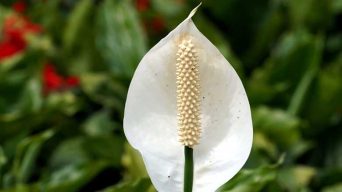Key Takeaways
- Peace lilies thrive in low to bright, indirect sunlight and require at least six hours of bright, indirect light per day for optimal growth and blooming.
- Direct sunlight can cause leaf scorch and yellowing, while insufficient light may hinder growth or cause a lack of bloom.
- Proper care techniques such as proper watering, soil preferences, fertilizing needs, pruning, and propagating techniques, as well as monitoring the plant for signs of over or underexposure, should be employed to keep peace lilies healthy.
- To maintain optimal sunlight exposure for your peace lily, consider placing it near an east-facing window with filtered sunshine or using artificial lighting sources. Regularly adjust its position accordingly to avoid over or underexposure.
Are you wondering how much sun your peace lily needs to thrive?
As a popular indoor plant, peace lilies provide stunning beauty and impressive air-purifying benefits.
Understanding their sunlight requirements is crucial in maintaining these incredible houseplants’ health, appearance, and blooming cycle.
In this guide, we will explore the unique sunlight needs of peace lilies while providing essential tips on placement, care techniques, and optimal growth conditions.
Understanding The Sunlight Needs Of Peace Lilies
For Peace Lilies to grow and bloom properly, it’s crucial to know their sunlight requirements.
They do best in conditions with bright, indirect light.
Optimal Light Exposure For Peace Lilies
Peace lilies thrive in low to bright, indirect sunlight, making them an ideal choice for a houseplant that adds elegance and beauty to your home’s interior.
Aim to provide at least six hours of bright, indirect light daily to ensure optimal light exposure for these graceful plants.
It is essential to monitor the lighting conditions throughout the day and consider any changes in weather or shadows cast by nearby objects like curtains or trees.
Adequate light exposure during daylight hours will encourage a healthy bloom cycle and growth of foliage.
Factors Affecting The Sunlight Needs Of The Plant
Numerous factors can influence the optimal sunlight needs of your peace lily, and it’s essential to consider these elements when caring for this popular houseplant.
One factor is the specific variety of your peace lily.
Another crucial aspect affecting sunlight requirements is the weather in your region.
For instance, if you live in an area prone to cloudy skies or frequent storms that limit natural light exposure throughout the day, you should supplement with artificial lighting sources like fluorescent lights or grow lights.
Additionally, changes in seasons should be considered when adjusting your plant’s access to sunlight.
It’s also worth noting how other environmental factors within your home can impact a peace lily’s light preferences.
If placed too close to air conditioning vents or heating systems, these fluctuations in temperature could stress out the plant and disrupt proper growth patterns.
The Impact Of Too Much Or Too Little Sunlight On Peace Lilies
Too much sunlight can harm your Peace Lily, causing leaf scorch and yellowing.
Direct sun exposure can result in burned leaves that become brown and fall off the plant, leading to overall poor health for the cherished houseplant.
On the other hand, insufficient light may hinder growth or cause a lack of blooming altogether.
To ensure optimal lighting balance and maintain a healthy Peace Lily, finding an appropriate place within your home where bright indirect light is available without exposing the plant directly to harsh rays is crucial.
For instance, placing your peace lily near an east-facing window with sheer curtains would provide enough filtered natural light without risking overexposure to direct sunlight.
This way, you can enjoy beautiful white blooms while keeping the temperature and humidity levels ideal for this lovely indoor plant’s well-being.
Ensuring Your Peace, Lily Gets The Right Amount Of Sunlight
To ensure your Peace Lily gets the right amount of sunlight, consider placing it in a bright but shaded spot near an east-facing window where it can receive indirect sunlight.
Adjust its position as needed to avoid over or under-exposure and monitor for signs of stress or damage.
Identifying The Best Placement For Peace Lilies In Your Home
Peace Lilies can adapt to different lighting conditions but thrive in bright indirect light.
Here are some tips on where to place your Peace Lily in your home:
- North-facing window: Place your Peace Lily near a north-facing window. This will give them the right amount of indirect light they need to thrive.
- Bright, filtered light: If you don’t have a north-facing window, look for a spot with bright, filtered light. You can achieve this by placing them near sheer curtains or blinds that filter the direct sunlight.
- Avoid direct sunlight: Direct sunlight can burn peace lily leaves, so it’s best to avoid it altogether. Place them away from windows that receive direct sunlight and keep them in a shaded area.
- Low-light spaces: Peace Lilies can also thrive in low-light areas such as bathrooms and basements, as long as they have access to some natural light.
Adjusting The Position Of The Plant For Maximum Light Exposure
Adjusting its positioning for maximum light exposure is crucial to ensure your peace lily gets the right amount of sunlight.
Here are some tips on how to do this:
- Observe the plant: Take note of where the sun shines in your home and observe how much light your peace lily receives throughout the day.
- Move it around: Depending on how much light your plant needs, you may need to move it around to find the perfect spot. Try placing it in different areas of your home until you find the right location with optimal light exposure.
- Use a plant stand: Placing your peace lily on a stand will allow you to move it closer or farther away from a window or artificial light source.
- Rotate the pot: Rotating the pot 180 degrees every few weeks will ensure that all leaves receive an equal amount of light and prevent one side from becoming overexposed.
- Use sheer curtains: If your peace lily is near a south-facing window, use sheer curtains to filter direct sunlight and protect the leaves from scorching.
Using Artificial Lighting Sources For Peace Lilies
Peace Lilies can benefit from artificial lighting sources to supplement their natural sunlight requirements, mainly when grown indoors.
Fluorescent lights provide adequate light levels for Peace Lilies and can be used as a substitute for natural sunlight.
When using artificial lighting sources, it is important to carefully monitor the amount and duration of light exposure.
Excess exposure to fluorescent or grow lights can cause leaf burn or damage the plant’s foliage.
The optimal amount of time for Peace Lilies under such lighting conditions should be 16-18 hours each day.
Additionally, remember that not all types of artificial lighting are suitable for Peace Lilies; LED lights may not provide enough spectrum range required by these plants.
Monitoring The Plant For Signs Of Over Or Underexposure
It’s important to watch your Peace Lily plant and ensure it’s getting the optimal amount of sunlight.
Signs of overexposure include yellowing leaves or brown tips, while drooping leaves may indicate underexposure.
An illuminance meter can also help determine if a spot suits your Peace Lily plant.
This tool measures light levels and can help determine if a particular location has enough light (or too much) for the plant’s needs.
Tips And Care For Your Peace Lily
To keep your Peace Lily healthy, taking good care of it is important.
This includes proper watering, using the right soil, fertilizing when necessary, and keeping an eye out for any signs of problems.
Proper Watering Techniques
Watering your peace lily correctly is crucial for its survival and health.
Below are some tips on proper watering techniques:
- Set the plant in the sink and pour water slowly onto the soil until liquid drips through the bottom of the pot. This ensures that the entire root ball is hydrated.
- Water your peace lily around once per week with about one inch of water. Overwatering can cause root rot while under-watering can result in wilting and yellowing leaves.
- Always allow the top layer of soil to dry out before watering again. This prevents waterlogging and allows for proper air circulation around the roots.
- Water thoroughly once the top half of the potting soil is dry. This helps to remove excess salts from fertilizer buildup that could harm your peace lily.
- Use distilled or rainwater, as tap water can contain chemicals such as fluorine and chlorine that can affect your peace lily’s growth. If you must use tap water, allow it to sit for 24 hours before using it to let any chemicals evaporate.
Soil Preferences And Humidity Levels
Peace lilies prefer moist, well-draining soil that holds some water but doesn’t become waterlogged.
Overwatering can lead to root rot and other plant diseases, while underwatering can cause the leaves to wilt and eventually die.
Maintaining proper humidity levels for peace lilies, especially in dry indoor environments, is also essential.
These plants thrive in high humidity conditions of 50% or more, so misting the leaves regularly or placing a tray of moistened gravel under their pot can help increase moisture levels around the plant.
Fertilizing Needs
Peace lilies are not heavy feeders but require proper fertilization to bloom and maintain their health.
During the growing season, typically in spring and summer, it’s recommended to use an organic houseplant fertilizer for peace lilies.
These plants are sensitive to chemical fertilizers, so be sure to choose the right type of fertilizer that will provide essential nutrients without causing damage.
Minimal amounts of fertilizer should be used as excessive feeding may result in overfertilization and damage to the plant.
Pruning And Propagating Peace Lilies
Pruning and propagating peace lilies are essential parts of taking care of them.
These tips will help you keep your plant healthy and vibrant.
- Pruning: Dead or dying leaves of peace lilies can be pruned down to the base of the plant. This will help remove any diseased parts and prevent further infection from spreading.
- Propagating by division: As peace lilies grow, they produce multiple stems from a single root system, which can be divided to create new plants. To do this, gently remove the peace lily from its pot and separate the root ball into sections using your hands or a sharp knife. Ensure each section has several stems with healthy foliage and replants in fresh soil.
- Propagating by cuttings: Another way to propagate peace lilies is through stem cuttings. To do this, cut a stem from the parent plant just below a node (a swollen part on the stem where leaves attach). Place the cutting in water or moist soil until roots form, then transplant it into fresh soil.
- Removing spent blossoms and leaves: To improve the health of your peace lily, regularly remove any brown or yellow leaves and spent flowers as they appear.
Monitoring And Observation Of Plant Symptoms
Monitoring the plant for any symptoms of over or underexposure is important to ensure that your peace lily is getting the right amount of sunlight.
Keep an eye on your plant and its reaction to its environment.
If you notice any discoloration or wilting, adjust its placement accordingly – whether by moving it to a different window or providing shade with a sheer curtain.
Final Thoughts
In summary, knowing the sunlight needs of your Peace Lily is crucial to ensure its growth and health.
While these plants prefer low-light conditions, they still require some exposure to indirect bright light for photosynthesis.
Providing adequate moisture and soil conditions is also essential to keep them thriving.
With our ultimate guide on how much sun a Peace Lily needs, you can now enjoy beautiful blooms and lush foliage all year round.
Remember to place your plant in an east-facing window with filtered sunshine or use artificial lighting sources and adjust its position for optimal results.







